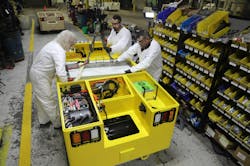Spurred by environmental initiatives and other factors, the ground handling industry continues to adopt electric ground support equipment (eGSE) for ramp operations. However, one of the barriers preventing even more use of electric equipment is the cost of replacing traditional internal combustion engine (ICE) units with electric versions.
To help alleviate this, some ground service providers are turning to conversion kits, allowing ICE-powered vehicles to be repowered.
Officials at Harlan Global Manufacturing say conversion kits are versatile and can be used across various GSE types, including cargo tractors, baggage tractors and pushbacks.
“We currently offer kits designed to repower the most popular styles of baggage and cargo tractors,” adds Gerry Hoadley, director of ground support equipment business at Waev Inc. “This simple, reliable technology that is developed for GSE could certainly be engineered to fit other equipment in the future.”
A key component to eGSE kits is the flexibility they provide GSE fleet managers, allowing for increased sustainability in multiple ways.
“Based on the needs and requirements of their company, they can choose to upcycle their existing fleet using their own labor or outside labor versus purchasing new equipment,” Hoadley says. “There also can be savings beyond the initial cost of a repower kit versus a new piece of equipment depending on how the company’s finances are structured, i.e. CAPEX versus OPEX.”
“Harlan e-conversion kits allow fleet managers to transform unreliable or retired cargo equipment into reliable electric vehicles,” officials at Harlan Global say.
Harlan officials also point to eGSE conversion kits’ favorable total cost of ownership.
“e-kits reduce maintenance needs, freeing up service centers,” they add. “In-service equipment takes less time in the shop.
“Converting with e-kits allows budgeting for parts, rather than capital equipment,” Harlan officials continue.
Conversion Kit Considerations
There are three main factors to consider when choosing a repowered vehicle versus new, according to Hoadley. They are cost, labor and timing.
“And before any purchase decision is made, assess each factor first,” he advises.
“For cost, know that the initial purchase cost and freight of the repower kit is less than the purchase of a new tractor,” Hoadley continues. “When looking at labor, does your team have the availability and skill to complete the work in-house? If not, what is the availability and cost associated with hiring out that work?
“Associated with labor, be mindful of space requirements for the work.”
Regarding timing, Hoadley notes how soon an operation needs the equipment will be a determining factor. For example, purchasing a new, electric tractor provides zero-emission operation from Day 1, without removing an existing vehicle from service.
As a result, Hoadley notes some customers opt to jump-start a repower program by purchasing new tractors while phasing in their repower work on legacy equipment.
“This works very well because our Tiger Repower kits use the same components as our Tiger Li-ion tractors, which leads to a standardized fleet of very similar tractors,” he points out. “This also can help with tight compliance deadlines, giving mechanics time to get educated on the repower implementation. It also supplements the fleet instead of straining it by pulling an otherwise in-use tractor.”
Officials at Harlan also recommend assessing budget, acquisition time and other factors when determining if a conversion kit is right for an operation.
“Conversion contributes not just to reducing CO2 emissions, it is recycling, reusing thousands of chassis, frames as well as parts – great to service other GSE,” company representatives say.
Harlan officials also note that e-conversion kits reduce the number of parts from the mechanical assembly, reducing the demand for spare parts inventory. They also add that the familiarity of existing vehicles can prove beneficial.
“Technical departments understand and have knowledge on their own equipment,” Harlan officials say.
Growing eGSE Demand
Demand for conversion kits is growing daily from operators that want to reduce their carbon footprint and unlock other benefits of electrification, according to Hoadley.
“Repowering existing equipment saves on emissions produced in the production and transportation of new equipment and leverages previous investments,” he points out.
“I believe the demand for companies to reach ESG targets, coupled with the low margins in the ground handling business created a requirement for the electrification of GSE to be as cost neutral as possible,” adds Scott Bellamy, director of GSE at Menzies Americas, who has utilized Waev’s conversion kits.
“I think one other benefit to the refurbishment and repowering of GSE is that in the short-term, there will be a need for spare parts in the industry,” he continues. “And in some cases, there are spare parts that can be kept and utilized on conventional GSE instead of going to a landfill, etc.”
The demand for compliance and the need to reduce operating costs correlate, explains Arnold Sue, president of ASAK Solutions, another user of Waev’s conversion kits.
“To date, the baggage tractor chassis has been uniform for almost 40 years,” says Sue. “The conversion kits allow current operators to remain in operation with minimal downtime, while keeping the GSE technicians engaged with performing the conversions process.”
Tractors that utilize conversion kits can be charged with little to no changes to airport infrastructure.
“Harlan’s e-kits come with built-in chargers that use 220-volt outlets, avoiding limitations of large charge stations,” company officials say, adding a fast-charging option is also available, which allows the 460-amp lithium iron phosphate battery to charge in two hours.
“There are several options for charging, including Level 2, which only requires a 240-volt single phase connection. This is ideal for low tempo airports or airports where 480v or 600v charging infrastructure is not available,” explains Bellamy. “The same kit can also be charged using a Level 3 fast charger, meaning if the unit ever has to be transferred to a station with charging infrastructure, there are no modifications required.”
“The advancements in eGSE reduce the impact on infrastructure restrictions – specifically, the technology with the lithium batteries, opportunity charging, low voltage on-board charging capabilities, and energy efficient programming,” adds Sue.
The decision to go electric, according to Hoadley, is driven by an individual airline or ground service provider that wants to reduce emissions, improve safety and minimize maintenance.
Officials at Harlan Global add net-zero goals and fleet efficiency drive adoption, especially for organizations with limited capital as they can acquire more e-kits than new units.
“In airports, large or small, infrastructure challenges remain to be the topic of discussion,” Sue says. “However, the flexibility in charging methods, ready to ship availability, expedient install process and custom-tailored capabilities all make the Waev Repower kit a viable option to all end-users.”
Time Requirements
The time required to repower an ICE-powered GSE unit to an electric version varies from case to case.
According to officials at Harlan, skilled technicians can typically remove unwanted parts in about 7 hours and perform the e-kit installation in 8-9 hours. The company offers a global training program that certifies engineers and mechanics for conversion kits installations.
“Traditional repower projects, such as changing an engine and transmission, can be time-consuming. However, installing an e-conversion kit is often comparable in terms of time,” Harlan officials note.
“After the ICE drivetrain has been removed from the tractor and it has been prepped for repower, complete installation of the Tiger Repower kit can be completed in 8-10 hours, using a two-person crew,” Hoadly says.
ASAK’s Sue and Menzies’ Bellamy have witnessed similar time requirements to convert vehicles.
“A complete project, to include disassembly, painting, fabrication and install, is completed within 80 labor hours. The Waev Repower kit offers great time-saving due to the wholistic approach,” Sue says. “All components are plug-and-play to include bolt-in components with very little fabrication needed.”
“On average, once the tractor has been refurbished, the time to install a conversion kit is about 14 hours,” Bellamy adds.
Once vehicles are converted to electric units, the life of the vehicle is extended. According to Bellamy, his company is still determining how much extra life a repower can provide a GSE unit.
“But as long as the refurbishment of the remainder of the tractor is performed to OEM standards, our hopes are to get at least 10 years out of our refurbished/repowered units,” he says.
“Based on battery life and components, we estimate an additional 7-year life expectancy,” Sue adds.
Officials at Harlan Global say an eGSE conversion kit can significantly extend the life of existing equipment because the structural frame of the unit remains intact, and the electric components enhance efficiency.
When exploring eGSE conversion kits, Harlan officials urge fleet managers to consider total cost of ownership – including installation, maintenance and energy costs; compatibility with existing equipment; and environmental benefits and regulatory compliance.
“In my opinion, I believe there is a use for conversion kits with airlines and ground handling companies, the size of the company shouldn’t matter as overall, the total cost of ownership should be lower than ICE-powered GSE and the upfront costs are still less expensive than replacing a unit with an ICE powered chassis,” Bellamy says.
“eGSE conversion kits contribute to a more sustainable aviation industry, reduce emissions and enhance operation efficiency,” Harlan Global officials conclude.
About the Author
Josh Smith
Editor
Josh Smith served as editor of Ground Support Worldwide as editor from 2016 through 2024. He oversaw production of the print magazine, created GSW's newsletters on a daily basis, and updated the latest news on AviationPros.com.

